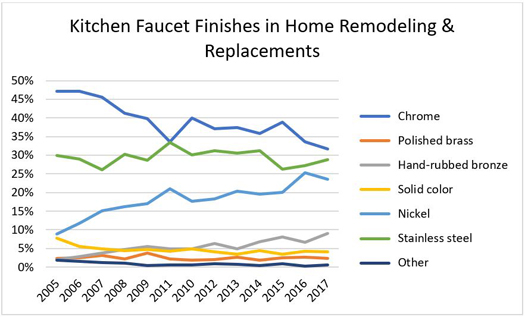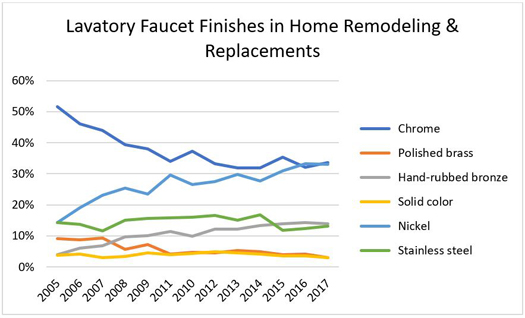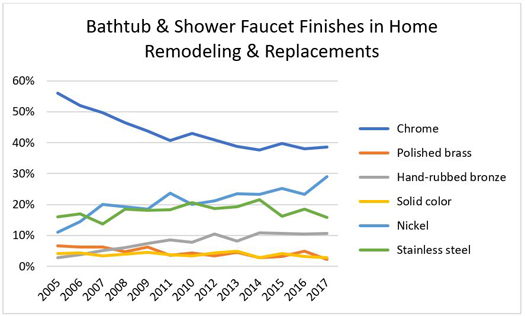September 7, 2018
Nickel for Your Thoughts … or Your Faucets? Remodeling Finish Trends
By: Ed Hudson, Market Research Director, Home Innovation Research Labs
What constitutes a trend in building products? Is something “on trend” because an interior designer says it is? Or because it’s all the rage at a kitchen and bath trade show? Or because it makes an episode of a home improvement TV program? Not necessarily. While those things may deem a product to be “trendy,” they do not truly constitute a trend. I’ve seen several home remodeling “design trend” articles recently that were very interesting and enlightening, but also contradictory in describing what’s becoming more popular in the market according to our data. The biggest disconnect I’ve seen seems to be in the discussion of faucet finishes. If you just looked at just a handful of those articles, you’d swear that all new faucets were bronze, and that neither chrome nor stainless steel finished faucets exists anymore.
Why are faucets and their finishes important? Volume. More than 35 million new faucets were sold in 2017 for installation in homes. More than 27 million faucets were installed in existing homes for remodeling and replacements — 44% were lavatory faucets and the remainder were split about evenly between bath/shower and kitchen faucets. In new homes, another 8 million were installed in 2017.
Styles and finishes change quickly in this space – unlike most construction materials, which are considered permanent, faucets are a smaller investment and are not always expected to last the lifetime of the home. On average, homes and apartments include about 6 faucets. That means there are about 800 million faucets in occupied homes in the United States currently. And with an average life cycle of each faucet being about 23 years – whether they’re changed to upgrade, fix a break, or change a home’s style – and about 27 million being replaced annually, the faucet market is vast.

Source: Home Innovation's Annual Consumer Practices Reports
As for finishes, Chrome is still the most popular in kitchens, although its popularity is waning, and Stainless Steel may soon overtake its lead position. Nickel finishes have seen the greatest boost in popularity in recent years, and Bronze has done well also. Single-lever kitchen faucets, now representing 75% of the market (up from 60% in 2005), continue to be far more popular than two-control models.

Source: Home Innovation's Annual Consumer Practices Reports
Lavatory sink faucet trends are similar but have some differences too. Chrome has fallen from its once-dominant position and is now about equal to Nickel — each holds about a third of the market today. Tied for the next two spots are Bronze, which is on the rise, and Stainless Steel, which is on the decline. Polished Brass has fallen from grace and now represents just a few percent of the market. In lavatories, about two-thirds of all controls are dual; the rest are single control. This contrasts starkly with kitchen (as noted previously) and bathtub faucets where single levers hold the overwhelming majority.

Source: Home Innovation's Annual Consumer Practices Reports
In bathtubs, Chrome still maintains the top position, but Nickel has seen a dramatic rise in the past decade. The popularity of Stainless Steel has fluctuated and seems to be waning modestly in the past few years. Bronze is still on the rise, but it’s not a serious contender to Nickel. As in kitchens, Brass seems be bottoming out. Also like with kitchen faucets, about three-quarters of all tub controls are single; in bathtubs, however, most are twist controls vs. levers.
I expect to see Nickel and Bronze continuing to take share. Nickel will continue to draw away from Chrome and Stainless, and Bronze will continue to grow because of its warm look and how it compliments lighter shades of cabinetry and countertops, which continue to be popular.
Want to know more about how your product category is doing in new homes and remodels? Get in touch. We’d love to help you understand the trends your product market is experiencing, or even uncover some new trends.
Back to Top